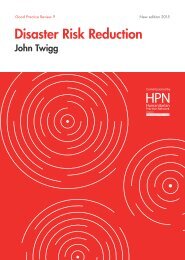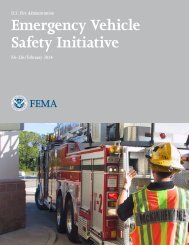Observer
2aEAQDf
2aEAQDf
You also want an ePaper? Increase the reach of your titles
YUMPU automatically turns print PDFs into web optimized ePapers that Google loves.
How culture mattered in Sandy<br />
One of the greatest challenges in disaster research is to<br />
understand the precise variables that lead to failure in a<br />
disaster-response process. It is easy to speak of “barriers<br />
to access.” And in some instances the problems are clear<br />
cases of poor planning, or structural failures on the parts<br />
of disaster response agencies. Many examples of such failures<br />
were in evidence in the case of Hurricane Katrina,<br />
where both the extent of the damage, as well as the services<br />
required by those impacted, were grossly underestimated<br />
and poorly executed. It is similarly tempting on<br />
the part of those institutions, as is common parlance in behavioral<br />
public health, to attempt to shift responsibility for<br />
those failures to the affected communities; these institutions<br />
appeal to a “responsibility framework” that treats as<br />
suspect people who may appear to be unable or unwilling<br />
to seek help in disaster circumstances. However, the experience<br />
of Staten Islanders following Sandy suggests an<br />
analytic middle ground that is in deep need of attention,<br />
by researchers and practitioners: Aspects of local culture<br />
can have significant influences on help-seeking behaviors,<br />
and thus long-term impact on the potential for resiliency<br />
of affected communities. At the same time, it is vital to recognize<br />
the longstanding political-economic relationships<br />
and ecological contexts in which local cultural patterns are<br />
embedded and to which people often have no choice but to<br />
adapt. As the examples below illustrate, it is typically the<br />
contrast between culturally based norms of behavior and<br />
expectations within communities, and those within responding<br />
institutions, which sets up conflicts and failures<br />
in the response and recovery processes (Browne 2015).<br />
Mental health services<br />
Focus groups with Disaster Case Managers (DCMs) 3 illustrated<br />
a number of counter-resiliency patterns in the experiences<br />
of home-owning, English-speaking, long-term<br />
residents of Staten Island, a demographic that would not<br />
3 In contrast to the FEMA case management system in place during<br />
Hurricane Katrina, the case management program for Hurricane Sandy was<br />
local, and residents were assigned to specific case managers throughout<br />
the process.<br />
generally be considered “vulnerable” in public health or<br />
disaster contexts. Applying local knowledge of this population<br />
helps to reveal that locally held political-economic<br />
patterns, ideologies, and recent experiences with previous<br />
storms led these residents to behave in ways that responding<br />
agencies did not anticipate. Lack of experience and<br />
comfort with seeking mental health services was one such<br />
area. As DCMs reported:<br />
“Clients are resistant to seeking therapy for dealing with<br />
trauma.”<br />
“Clients resist acknowledging their needs.”<br />
“Many feel too proud or embarrassed.”<br />
These quotes are consistent with observed patterns in the<br />
dominant culture on Staten Island, patterns which would<br />
not have been surprising to a cultural insider, or even to<br />
anyone familiar with the notion that use of mental health<br />
services varies greatly across demographics. As with many<br />
failures to take into account local cultural tendencies, services<br />
should not be framed only in terms of anticipated<br />
need, but in terms of asking the question about potential<br />
culturally influenced variation in health-seeking behaviors.<br />
Additionally, while there is a significant local stigma<br />
placed on seeking mental health services, there is also a<br />
longstanding pattern of the use and abuse of prescription<br />
painkillers and other drugs on Staten Island. It is beyond<br />
the scope of this article to examine the potential interaction<br />
between these trends and the disaster response. But it<br />
is worth noting that the current opiate epidemic on Staten<br />
Island likewise has cultural roots. Among both those seeking<br />
treatment and general health practitioners, there is a<br />
far higher level of comfort with utilizing prescriptions to<br />
address problems that can be defined as physical in origin,<br />
rather than seeking counseling for problems of a social or<br />
psychological nature. Agencies seeking to evaluate the disaster<br />
recovery process in a context such as Staten Island<br />
may be tempted to dismiss people who are reluctant to<br />
seek services as unwilling or uninterested to take action<br />
to improve their own recovery. In doing so, these agencies<br />
fail to account for how local cultural biases or behavior pat-<br />
12 Natural Hazards <strong>Observer</strong> • June 2016







